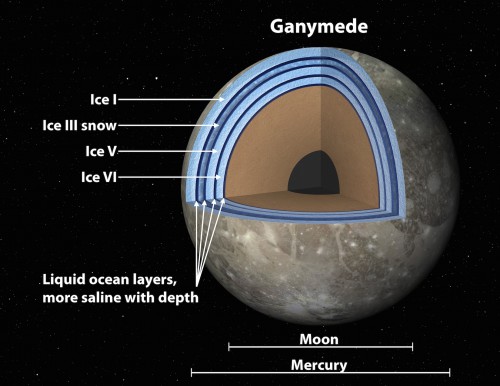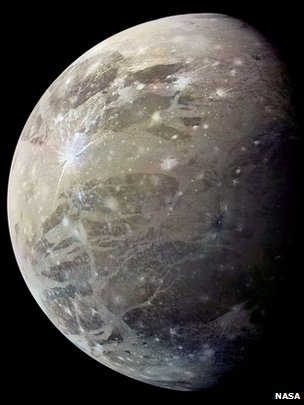
Europa and Enceladus, for good reason, have captured the attention and imagination of those searching for evidence of life elsewhere in our Solar System. Both moons are now thought to have subsurface oceans with conditions where life could possibly exist, as well as Jupiter’s moon Callisto. Saturn’s largest moon Titan may also have an ocean beneath its extremely cold surface of rock-hard ice and liquid methane seas and lakes. There is another moon with evidence for a similar ocean as well, Ganymede, but until now this ocean has been considered less likely to be able to support life. New findings, however, are now causing scientists to re-evaluate this possibility.
Like these other moons, Jupiter’s moon Ganymede, the largest moon in the Solar System and larger than Mercury, was thought to have a deep ocean of water below its frozen surface, first suspected in the 1970s and later confirmed by the Galileo spacecraft in the 1990s. The problem was, it seemed to be between two layers of ice, instead of being in contact with a rocky core like the other moons. This meant it was unlikely to have any minerals getting mixed into the water that could be used as nutrients by organisms like in Earth’s oceans.
The new research suggests, however, that Ganymede’s ocean is not a single deep layer of water between layers of just ice, but is a series of oceans layered like a “club sandwich” where the ocean layers alternate with layers of ice and the bottom ocean has a rocky seafloor. That deepest ocean is also thought to be the saltiest; a salty water ocean in contact with the rocky core, a similar environment to Earth’s oceans, would greatly increase the chances that life of some sort could have developed.

“Ganymede’s ocean might be organized like a Dagwood sandwich,” said Steve Vance of NASA’s Jet Propulsion Laboratory in Pasadena, Calif. “This is good news for Ganymede,” he continued. “Its ocean is huge, with enormous pressures, so it was thought that dense ice had to form at the bottom of the ocean. When we added salts to our models, we came up with liquids dense enough to sink to the sea floor.”
The new study supports the idea that the ocean layers are sandwiched between at least three ice layers and the bottom rocky core. The lightest and least dense forms of ice, similar to ordinary ice in ice cubes, are at the top, while the heaviest and densest are farther down where the pressures are enormous. As Vance explained it, “It’s like finding a better arrangement of shoes in your luggage – the ice molecules become packed together more tightly.”
This new model of Ganymede’s interior oceans may also be applicable to some exoplanets (and, of course, exomoons). One type of exoplanet being found is the “super-Earth” which is larger than Earth but smaller than Uranus or Neptune. Some of these are thought to be water worlds covered in global surface oceans. What forms of life might inhabit those alien yet familiar environments? The environments found on these “water moons” in our Solar System may provide clues to what might be found in those other alien oceans as well.
The new findings were published in the journal Planetary and Space Science.
Want to keep up-to-date with all things space? Be sure to “Like” AmericaSpace on Facebook and follow us on Twitter:@AmericaSpace




Looking forward to real ‘Farmers in the sky.’
In an earlier comment, I called for an armada of spacecraft to explore the moons of Jupiter and Saturn. This study strongly supports the notion that the discovery of life is in our “backyard.” Let’s do it!